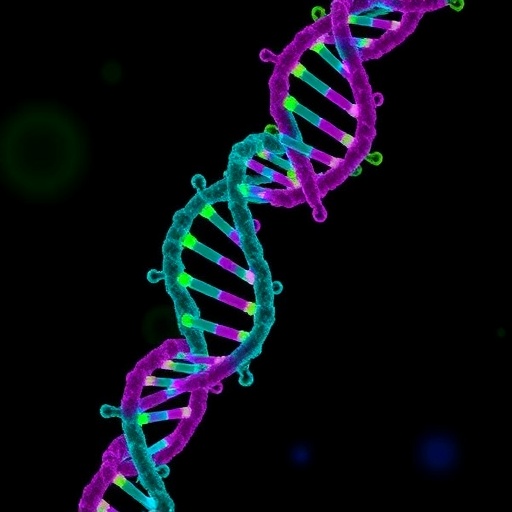Recent advances in the realm of food safety have unveiled a crucial mechanism by which certain bacterial spores can protect their genetic material during extreme conditions. A recent study led by researchers Seo, M., Kim, B., and Shin, H. sheds light on the structural and dynamic basis of Ssp4-mediated DNA protection in foodborne bacterial spores, a discovery that could have profound implications for understanding bacterial resilience and developing strategies to combat foodborne pathogens.
Foodborne illnesses remain a significant public health challenge globally, impacting millions and resulting in considerable economic losses. Within this context, spores of certain bacteria, such as Bacillus and Clostridium species, have evolved sophisticated strategies to survive harsh environmental conditions, including extreme temperatures, desiccation, and radiation. Understanding how these spores maintain the integrity of their DNA when faced with such stressors is pivotal for devising effective interventions to ensure food safety.
In their study published in Scientific Reports, the researchers employed advanced techniques to elucidate the role of the Ssp4 protein in the protection of bacterial DNA. The Ssp4 protein is a small, intrinsically disordered protein that plays a critical role in the spore’s resistance mechanisms. The team delved into the intricate structural characteristics of Ssp4, revealing how it binds to DNA and provides a protective shield that prevents damage.
Utilizing a combination of nuclear magnetic resonance (NMR) spectroscopy and X-ray crystallography, the researchers were able to visualize the interactions between Ssp4 and DNA at an atomic level. This structural analysis is pivotal because it not only confirms the protective role of Ssp4 but also provides insights into its dynamic behavior under stress conditions, which is integral to the spore’s overall resilience.
Moreover, the study made significant strides in understanding the dynamic nature of the Ssp4-DNA interactions. The researchers noted that under desiccation stress, the conformation of Ssp4 changes, allowing for more effective binding to DNA. This adaptability is a striking example of how bacterial proteins can evolve to maximize their survival in unpredictable environments.
The findings suggest that Ssp4 acts as a molecular sentinel, ready to engage with DNA whenever there’s a risk of damage. The protective umbrella formed by Ssp4 not only safeguards the genetic material from environmental stressors but also likely plays a role in the germination process when conditions become conducive for growth. Such insights into the functionality of Ssp4 could guide the development of new biotechnological applications, including the design of food preservatives that inhibit bacterial spore formation or germination.
Additionally, the researchers discussed the evolutionary implications of their findings. The ability to protect DNA is a double-edged sword; while it enhances the survival of foodborne pathogens, a better understanding of these mechanisms could lead to targeted strategies to exploit these vulnerabilities. By identifying the molecular features that confer DNA protection, scientists may be able to engineer interventions that disrupt these protective mechanisms, thereby enhancing food safety.
The implications of Ssp4’s role in DNA protection extend beyond food safety; they may also inform our understanding of other bacterial species that employ similar strategies. With the emergence of antibiotic resistance being a growing concern, insights into the molecular biology of spore-forming bacteria could pave the way for novel therapeutic approaches aimed at combating resistant strains.
Furthermore, discussions around the importance of understanding bacterial spores have been gaining traction in various sectors, including agriculture, pharmaceuticals, and food production. By investing in research that elucidates the mechanisms of spore protection and resilience, stakeholders can make informed decisions that contribute to more effective safety standards and practices.
To conclude, the groundbreaking work conducted by Seo, M., Kim, B., and Shin, H. marks a significant milestone in our understanding of bacterial spores and their protective mechanisms. As the world grapples with the necessity for enhanced food safety measures, the insights garnered from this research hold promising potential. Not only does this study underscore the complex interplay between bacteria and their environment, but it also illuminates pathways toward safeguarding public health against foodborne diseases.
In the coming years, we can expect to see further developments in this field, as researchers build on these foundational insights. The journey to understand bacterial spores is far from over, and as we unravel the molecular mysteries behind spore resilience, we move closer to creating a safer food supply for all.
Subject of Research: Mechanism of DNA protection in foodborne bacterial spores through Ssp4 protein.
Article Title: Structural and dynamic basis of Ssp4-mediated DNA protection in foodborne bacterial spores.
Article References:
Seo, M., Kim, B., Shin, H. et al. Structural and dynamic basis of Ssp4-mediated DNA protection in foodborne bacterial spores.
Sci Rep 15, 37299 (2025). https://doi.org/10.1038/s41598-025-21159-3
Image Credits: AI Generated
DOI: 10.1038/s41598-025-21159-3
Keywords: Ssp4, DNA protection, bacterial spores, foodborne pathogens, resilience mechanisms.
Tags: advanced techniques in food microbiology researchBacillus and Clostridium spore survival strategiesbacterial spore DNA integrity maintenancecombating foodborne illnesses through molecular understandingDNA protection in extreme conditionsfood safety and public health implicationsfoodborne pathogen resilience mechanismsimplications for food safety interventionsScientific Reports study on Ssp4 protein.Ssp4 protein function in bacterial sporesstructural basis of Ssp4-mediated DNA defenseunderstanding bacterial resilience in harsh environments





